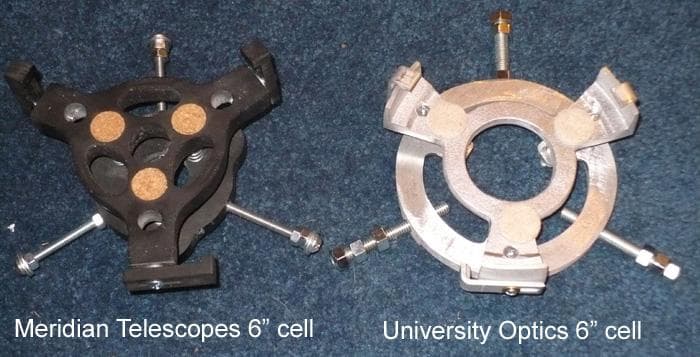
with David Fuller

Mirror cells: University Optics and Meridian Telescopes
Below is a review and specifications comparison of two 6" mirror cells for reflector telescopes; one sold by Meridian Telescopes, and the other by University Optics. Here's what you need to know about each!
University Optics 6” primary mirror cell: Review
I have been working on two 6” telescopes. Rather than build my own primary mirror cells for them, I first started out by purchasing the University Optics 6” primary mirror cell. This is a very nice, well-made cast aluminum piece of equipment. It has spring-tensioned collimation screws, locking collimation screws as well, mirror clips, hard felt pads, and beefy 3/8-16 bolts as cell attachment hardware (included!). It looks strong, it FEELS strong, and it has a nice open structure to it for primary mirror cooling. I plan to use this cell in my 6” f/5 scope, which I am in the process of rebuilding. The heavier weight will be helpful too, as the 2” Antares focuser I purchased for the new tube is rather bulky and heavy. The counterweight action of the heavy cell will help.
Some strong points about it: Additional aluminum where the mounting bolts are inserted. This undoubtedly gives it some extra rigidity. The raised sides will certainly keep the mirror from sliding out of place, and the overall look from a structural point of view is very good. Aesthetically, it looks like it was placed under a wife brush to quickly knock off any odd marks, but this leaves the finish looking a bit strange in areas. But for $50, that's not worth complaining about. A full finish of anodizing or powder coating would likely double the price.
A few specific things I don't like about it though, and these are largely cosmetic, though one is design related:
-
The biggest complaint, as I see it, is the limited collimation adjustment movement available. From as far out as I dare leave a wingnut barely hanging onto a thread, down to “spring squeezed tight” bottomed out, there's only 0.312” of movement. Now, that's plenty if you know exactly where your mirror needs to go, and perhaps the right amount if you don't want to allow too much motion with a longer screw / spring set up. But it leaves little room for error if you don't know exactly where your cell needs to be in the tube. Drill those cell hardware screws VERY carefully!

- The hardware bolts aren't actually bolts, per se. The ends have lock-nuts on the end, which makes them even larger and bulkier than 3/8” bolts would be. I may replace these, as from an aesthetic standpoint, I don't care for this look. I'm also not sure why they was done; longer 3/8” bolts can be purchased rather easily.
-
The felt pads. One was glued on out of place (see picture). They also aren't terribly hard. As someone who has done some piano-tuning and fix-up work (I have a nice-sounding 1927 baby grand), I'm aware that felt can be made to rather hard densities. This felt that is included is fairly hard, but I'd rather see the denser type material I'm used to from my piano work. It would protect the mirror on the bottom just fine, and not allow any change over very long periods of time. But that's also a bit of a nit-pick.

-
No washers included with mounting hardware. Again, a nitpick, but it would have been nice.
-
What appears to be brass washers on the mirror clip adjustment screws. For most people, these will be hidden anyway, but in a more open design, they'd be obvious. I don't quite see why these are standard; zinc-plated steel or even aluminum washers are readily available. Again, an aesthetic thing, and minor.
Admittedly, most of these are minor aesthetic quibbles, but I want to let readers know exactly what they are getting so they can be prepared. Overall, I think this is a great mirror cell, and I hope it works well in my new OTA. Of course, if I find it has issues, I'll post updates, but for now, it looks and feels like a solid, well-constructed piece of equipment.

Underside view of the University Optics 6" mirror cell.
Meridian Telescopes 6” primary mirror cell: Review
I got this cell because I also have a very long focal length 6” mirror – an f/10.9 one to be exact. Since I don't have the money to get a Hastings Irrigation tube (yet), I have constructed a temporary tube by using two 8” (nominal) concrete pier tubes taped together, and shellacked to increase the wall strength. Because I am trying to keep this overall tube lighter since it will have a longer moment arm and more mass, this cell makes more sense. Weighing in at just a hair over 14 ounces, it's a full half pound less than the University Optics one. However, there are some differences worth noting.
I recall reading some folks worrying that the urethane would warp or flex. Won't happen. This stuff is SOLID and strong. It probably doesn't have the same strength as aluminum, but given that, for this cell at least, it is only holding a mirror weighing a few pounds, the strength difference is entirely irrelevant. It's quite rigid.
Continuing on the positive side, the urethane shouldn't hold much heat. This is good, especially for this telecope, as I want to remove as much heat as possible for excellent planetary images. The small overall “footprint” of the lower portion of the cell, coupled with the triad-shaped upper section means that a fan will be able to quickly dissipate heat from a mirror. Also, the much longer travel length of the collimation screws means I will have some “wiggle room” in case I place the cell 1/4” too high or low compared to the focuser.

But there are a few drawbacks.
-
The collimation screws are much closer to the center of the cell compared to the UO one (1” versus 2.375”). Given that the collimation screws on both cells are 10-32 threads, this means less turning of the MT wingnuts will change the collimation a lot more. That may or may not be a problem, but given that I tend to do a half or quarter turn each time I try collimating, this means the potential for “overcorrecting” a lot more easily.
-
Another thing is the attachment hardware. The UO uses 3/8-16 hardware, this MT cell has 1/4-20 hardware included. The lower cell is also only 1/2” thick. I don't know if there will be warping issues or subtle changes, but this does two things: a) It does make the cell lighter, which is good for me but b) it means it may not be as stable. Of course, my flimsier tube for now may play a larger role there, so I won't render too harsh of a judgement on the cell just yet. But another thing to be concerned about if you're using a much larger tube.
-
The last thing is the cork pads. Not only are they very thin, they are very close to the center of the cell – the centers of each are only 1” from the center of the cell. That means at least 1.5” of the mirror will be hanging off the outside of it. I don't know if mirror cell support software like PLOP says that's appropriate for a 6” cell, but it seems too close for me. I will likely replace that cork with the hard piano felt that I plan to use on the other one too, and move it a bit further out.

One last point about this cell. It does not have a molded outer edge. The UO cell has been cast/cut to a maximum diameter, and no provision for smaller (without shims, anyway). But the MT cell uses the clips themselves to act as the outer “edge” so to speak, and there are a couple washers in place to increase that edge slightly for a 6” mirror. But what that also means is that a 150mm mirror – 2.4mm smaller in diameter than a 6” one – can easily be used on this cell. I suppose an oddball mirror size of 6.25” and perhaps even 6.5” could be used on it as well. It's got the ability to handle that kind of adjustment. Something to bear in mind, if that is necessary for your application.
Overall, I like this cell too, for the intended purpose I plan for it. The long focal length will be forgiving of the more acute collimation adjustment movements, and the larger adjustment range will be good for finding the focal “sweet spot” more easily. The hardware, while smaller, is also likely to be more aesthetically pleasing once I get a more attractive tube. But I will have to replace the mirror pads, yet the steady specific heat of the material and the large, open structure should avoid the heat that can ruin high magnification images. Again, I'll certainly update my thoughts on it after I've had a chance to install it and use it.

Underside view of Meridian Telescopes 6" mirror cell
MIRROR CELL SPECIFICATIONS
University Optics 6” mirror cell
Specifications
Weight, as purchased with all hardware: 1 pound, 6.5 ounces
Primary construction material: Cast Aluminum
Total collimation movement distance: 0.312”
Collimating style: Wingnuts with springs on screws
Collimation locking screws: Yes
Tube attachment hardware included: Yes
Tube attachment hardware size: 3/8-16 bolts x 3, locking nuts x 3, regular nuts x 3
Mirror seating material: 1” diameter x 1/8” thick hard felt
Mirror seating material distance from center: 1.75”
Mirror clips: Yes
Mirror clip pads: Yes, 1/8” felt
Mirror clips adjustable: Yes, 1.334” (not including clip-pad thickness)
PRICE: $49.95
Meridian Optics 6” mirror cell
Specifications
Weight: 14.125 ounces
Primary construction material: Hard urethane plastic
Total collimation movement distance: 0.60”
Collimating style: Wingnuts with springs on screws
Collimation locking screws: No
Tube attachment hardware included: Yes
Tube attachment hardware size: 1/4-20 Phillips head screws x 3, 1/4-20 washers x 6, 1/4-20 nuts x 6
Mirror seating material: 0.75” diameter x 0.063” thick cork
Mirror seating material distance from center: 1”
Mirror clips: Yes
Mirror clip pads: No
Mirror clips adjustable: Yes, to 1.050”
PRICE: $39.95

